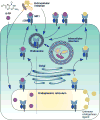MAIT cells and microbial immunity
- PMID: 29451704
- PMCID: PMC6045460
- DOI: 10.1111/imcb.12022
MAIT cells and microbial immunity
Abstract
Mucosal-associated invariant T (MAIT) cells, the most abundant T-cell subset in humans, are increasingly being recognized for their importance in microbial immunity. MAIT cells accumulate in almost every mucosal tissue examined, including the lung, liver and intestinal tract, where they can be activated through T-cell receptor (TCR) triggering as well as cytokine stimulation in response to a host of microbial products. In this review, we specifically discuss MAIT cell responses to bacterial and fungal infections, with a focus on responses that are both MR1-dependent and -independent, the evidence for diversity in MAIT TCR usage in response to discrete microbial products, protective immunity induced by MAIT cells, and MAIT cell antimicrobial functions in the context of these infections.
Keywords: MAIT cells; MR1; antimicrobial responses; infection; mucosal immunology; unconventional T cells.
© 2018 Australasian Society for Immunology Inc.
Conflict of interest statement
The authors declare no conflict of interest.
Figures

References
-
- Treiner E, Duban L, Bahram S, et al. Selection of evolutionarily conserved mucosal-associated invariant T cells by MR1. Nature. 2003;422:164–169. - PubMed
-
- Le Bourhis L, Martin E, Peguillet I, et al. Antimicrobial activity of mucosal-associated invariant T cells. Nature Immunol. 2010;11:701–708. - PubMed
Publication types
MeSH terms
Grants and funding
LinkOut - more resources
Full Text Sources
Other Literature Sources
Medical

